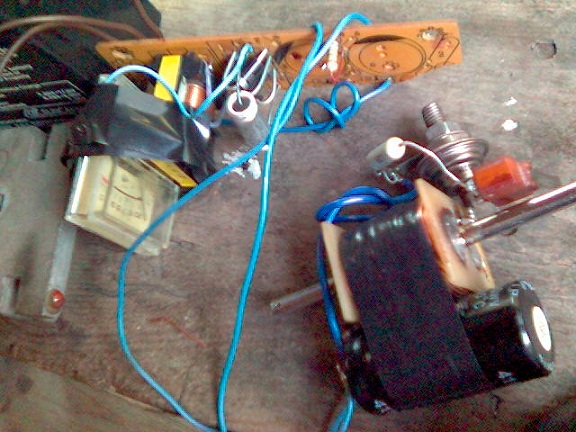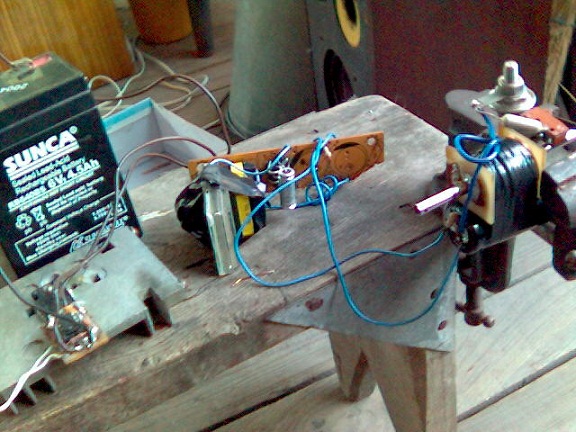Gauss gun - the legend of 3% efficiency
 Somehow on the Internet, I found an article about the Gauss gun and thought that it would be nice to get one (or even two) for myself. In the process of searching, I came across the gauss2k website and, according to the simplest scheme, assembled a super-cool-mega-gauss-gun.
Somehow on the Internet, I found an article about the Gauss gun and thought that it would be nice to get one (or even two) for myself. In the process of searching, I came across the gauss2k website and, according to the simplest scheme, assembled a super-cool-mega-gauss-gun. Here she is:

And he shot a little:
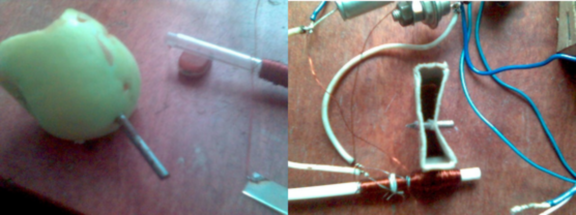
And I was taken here by a sadness-sorrow strong that I didn’t have a super-cool gun, but a fart, of which there were many. I sat down and began to think how could I increase the efficiency. I thought for a long time. Year. I read the entire gauss2k and the floor of the evoy forum. Invented.
It turns out that there is a program written by scientists overseas, and our craftsmen doped up a Gaussian cannon, and it is called nothing more than FEMM .
I downloaded the .lua script from the forumYes, the program is overseas version 4.2 and prepared to hit scientific calculations. But there it was, the overseas program did not want to run the Russian script, because the script for version 4.0 was made. And I opened the instruction (they call it a manual) in the bourgeois language and completely burnt it. The great truth was revealed to me that in the script, cursed, you must first add a tricky line.
Here she is:
setcompatibilitymode(1) -- включаем режим совместимости с версией femm 4.2And I sat down for a long calculation, my counting machine buzzed, and I received a description of a scientist:
Description
Capacitor capacity, microfarad = 680
Voltage across the capacitor, Volt = 200
Total resistance, Ohm = 1.800147899376892
External resistance, Ohm = 0.5558823529411765
Coil resistance, Ohm = 1.244265546435716
Number of turns in the coil = 502.1193771626296
Coil wire diameter, coil
length = 0.64, 4 m = 22.87309092387464
length coil = 26 millimeters
outer diameter of the coil = 24 millimeters
coil inductance with a bullet in the initial position, microhenries = 1044.92294174225
outer barrel diameter = 5 millimeters
bullet weight, grams = 2.450442269800038
bullet length = 25 millimeters
Diamé p bullets Millimeter = 4
The distance at which the bullet is pulled into the coil at the initial moment, millimeter = 0
Material of which the bullet was made = No. 154 Experimentally selected material (simple iron)
Process time (microsec) = 4800
Increment in time, microsec = 100
Bullet energy J = 0.2765589667129519 Condenser
energy J = 13.6
efficiency of the house (%) = 2.033521814065823
Initial speed of the bullet, m / s = 0
Speed of the bullet at the exit of the coil, m / s = 15.02403657199634 The
maximum speed that was achieved, m / s = 15.55034094445013
Voltage across the capacitor, Volt = 200
Total resistance, Ohm = 1.800147899376892
External resistance, Ohm = 0.5558823529411765
Coil resistance, Ohm = 1.244265546435716
Number of turns in the coil = 502.1193771626296
Coil wire diameter, coil
length = 0.64, 4 m = 22.87309092387464
length coil = 26 millimeters
outer diameter of the coil = 24 millimeters
coil inductance with a bullet in the initial position, microhenries = 1044.92294174225
outer barrel diameter = 5 millimeters
bullet weight, grams = 2.450442269800038
bullet length = 25 millimeters
Diamé p bullets Millimeter = 4
The distance at which the bullet is pulled into the coil at the initial moment, millimeter = 0
Material of which the bullet was made = No. 154 Experimentally selected material (simple iron)
Process time (microsec) = 4800
Increment in time, microsec = 100
Bullet energy J = 0.2765589667129519 Condenser
energy J = 13.6
efficiency of the house (%) = 2.033521814065823
Initial speed of the bullet, m / s = 0
Speed of the bullet at the exit of the coil, m / s = 15.02403657199634 The
maximum speed that was achieved, m / s = 15.55034094445013
And then I sat down to realize this witchcraft into reality.
I took the tube from the antenna (one of the sections D = 5mm) and made a drink in it (grinder), because the tube is a closed coil in which cursed currents, eddy currents will be induced, and they will heat this tube, reducing the efficiency, which is already low .
Here's what happened: ~ 30 mm slot I

started to wind the coil. To do this, I cut out 2 squares (30x30 mm) from foil fiberglass and with a hole in the center (D = 5 mm) and etched the sly tracks on it to solder it to the tube (although it glitters like a piece of iron, it is actually brass).
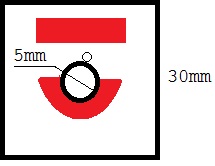
With all this good, I sat down to reel: I
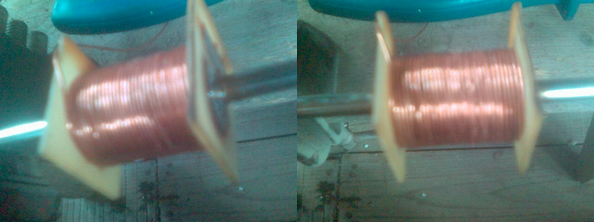
reeled. And according to the same scheme, he assembled this tricky device.

Here's what it looks like:

Thyristor and Mikrik were from old stocks, but I got a capacitor from a computer PSU (there are two of them). Later, from the same PSU, a diode bridge and an inductor converted into a step-up transformer were also used, because it is dangerous to charge from the outlet, and it is not in a clean field, and therefore I need a converter to build it. To do this, I took a previously assembled generator on the NE555:

And connected it to the inductor:
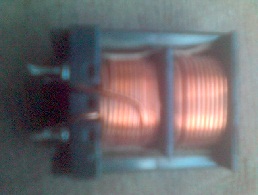
which had 2 windings of 54 turns of 0.8 wire. I fed it all from a 6 volt battery. And there is some kind of witchcraft - instead of 6 volts at the output (the windings are the same), I got as much as 74 volts. Having smoked a pack of manuals on transformers, I found out:
- As you know, the current in the secondary winding is greater, the faster the current in the primary winding changes, i.e. proportional to the derivative of the voltage in the primary winding. If the derivative of the sinusoid is also a sinusoid with the same amplitude (in the transformer, the voltage value is multiplied by the transformation coefficient N), then with rectangular pulses the situation is different. At the leading and trailing edges of the trapezoidal pulse, the rate of change of voltage is very high and the derivative at this point is also of great importance, hence the high voltage.
Gauss2k.narod.ru “A portable device for charging capacitors.” Posted by ADF
After a little thought, I came to the conclusion: since I have an output voltage of 74 volts, but I need 200 then - 200/74 = 2.7 times I need to increase the number of turns. Total 54 * 2.7 = 146 turns. I rewound one of the windings with a thinner wire (0.45). The number of turns increased to 200 (in reserve). I played around with the frequency of the converter and got the coveted 200 volts (in fact 215).
Here's what it looks like:
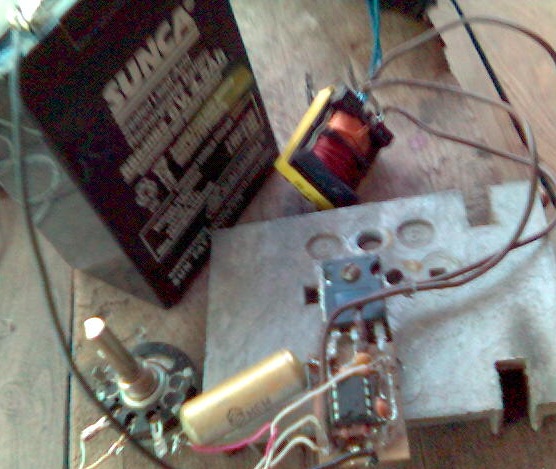
Ugly, but this is a temporary option then will be redone.
Gathering all this stuff, I shot a little: After shooting, I

decided to measure what kind of performance characteristics of my gun. Started by measuring speed.
After sitting in the evening with paper and pen, I derived a formula that allows you to calculate the speed along the flight path:

Using this tricky formula I got:
distance to the target, x = 2.14 m
vertical deviation, y (arithmetic average of 10 shots) = 0.072 m
Total:

I didn’t believe it at first, but subsequently collected punch sensors connected to the sound card showed a speed of 17.31 m / s
. I was too lazy to measure the mass of the clove (and there was nothing) so he took the mass that FEMM counted for me (2.45 grams). Found efficiency.
Energy stored in the capacitor = (680 * 10 ^ -6 * 200 ^ 2) / 2 = 13.6 J
Bullet energy = (2.45 * 10 ^ -3 * 17.3 ^ 2) / 2 = 0.367 J
Efficiency = 0.367 / 13.6 * 100% = 2.7%
That's basically all that is connected with a single-stage accelerator. Here's what it looks like:
